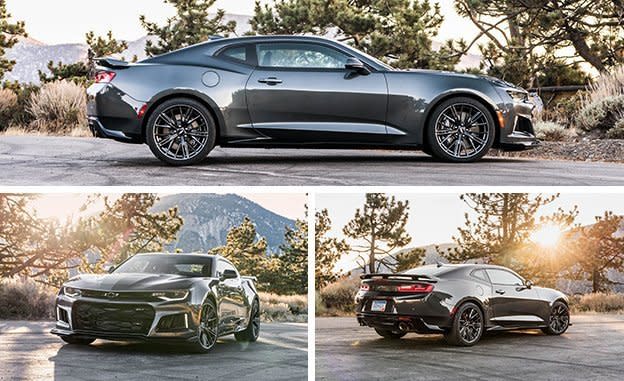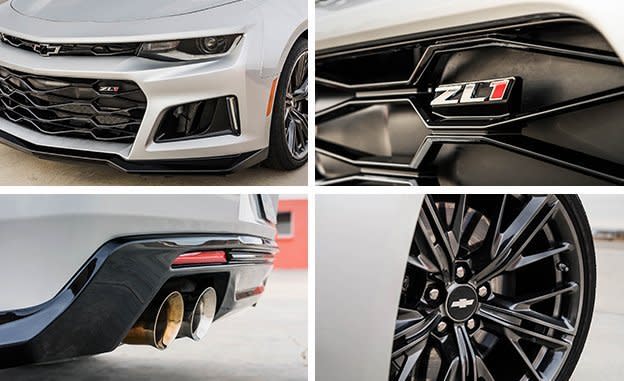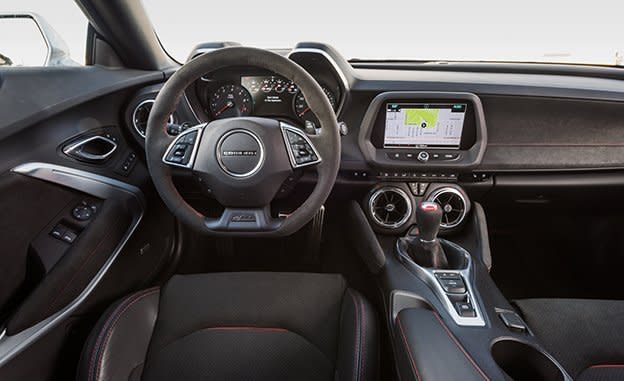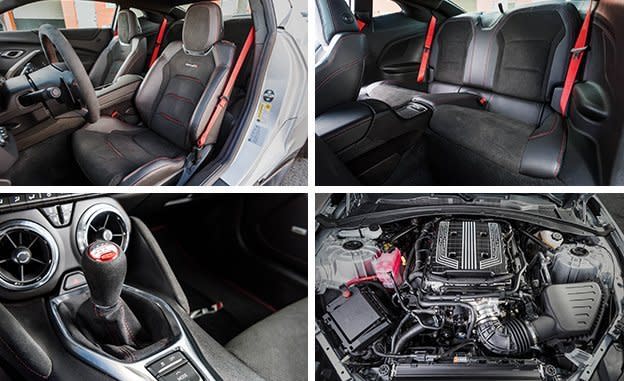2017 Chevrolet Camaro ZL1 Coupe

The 2017 Chevrolet Camaro ZL1 is built from some of the most awesome automotive hardware there is. Its magnetorheological dampers read the road 1000 times per second. An electronically controlled limited-slip differential metes torque between the rear wheels with microchip-controlled precision. A wet-sump variant of the Corvette Z06’s supercharged 6.2-liter LT4 V-8 delivers incredible thrust. The Camaro ZL1 packs 650 horsepower, with the drivetrain hardware to put it to the ground and the chassis to wrangle it around any curves, all for $63,435.
Imagine a Dodge Challenger SRT Hellcat that can corner, a Ford Mustang Shelby GT350 with an additional 124 horsepower, and a BMW M4 with great steering. The Camaro ZL1 is all of these things and more.

Poke the Lion
If the ZL1’s components list sounds familiar, you probably recognize this car as a Corvette Z06 with four seats. But the ZL1 offers its own contribution to Chevy’s arsenal of performance parts with its new 10-speed automatic transmission, GM’s first application of the 10R gearbox developed jointly with Ford. While Ford engineers led the 10-speed engineering effort, the ZL1’s Hydra-Matic 10R90 is a high-torque application developed by Chevrolet engineers exclusively for their own use. Their changes include a different torque converter, GM-exclusive control algorithms, and uprated components in the clutches, the planetary carriers, and the output gearset to cope with the LT4’s brutal 650 lb-ft of torque.
The real magic, though, is in the tuning. ZF’s acclaimed eight-speed automatic, used by BMW, Fiat Chrysler, Jaguar Land Rover, and the Volkswagen Group, finally has a worthy rival. In Los Angeles traffic, the transmission shuffled through the ratios virtually imperceptibly. At any speed, it shifts with minimal fuss and never hunts for the right ratio. When you demand thrust, the gearbox executes a quick yet smooth downshift without any intermediate steps. Mat the throttle from 60 mph, and the gearbox executes a flawless 10th-to-third transition that wakes the LT4 like a sleeping lion poked with a cattle prod.
Switching between the ZL1’s driving modes brings only minor changes to the transmission calibration. The engine cuts fuel on upshifts for faster gear swaps and a satisfying blat in Sport and Track, yet the computer still targets the same shift points.

However, once you begin driving enthusiastically in Sport or Track mode, one of three performance algorithms for the transmission is automatically triggered. The initial level holds gears when you lift off the throttle and matches revs on downshifts; the most aggressive one constantly holds the lowest possible gear. The controller monitors throttle and brake inputs and lateral g’s to activate performance shifting or to revert to the standard algorithm after a period of soft-pedaling. The only way to decipher which performance algorithm is active is to study where in the 7500-rpm tachometer the needle is spending its time. It’s a slightly strange and opaque way to control the transmission logic, but it works surprisingly well. All it takes is a single corner of hard driving to trigger the behavioral change.
The sheer number of gears removes a lot of the joy from manually paddling through the cogs, not to mention that these paddle-actuated shifts feel significantly slower and clunkier than when the gearbox is left to its own devices. Engineers did attempt to address the tedium of toggling through six, seven, or eight gears by writing code that jumps to the lowest possible gear when you hold the left paddle, but we found the system to be wildly inconsistent. Sometimes the downshift was nearly instantaneous. Other times, whole seconds passed before the shift occurred. And sometimes, inexplicably, there was no shift at all, no matter how long we held the paddle.
Want to choose your own gears? Stick with the standard six-speed manual gearbox. Its shifter is topped by a well-weighted suede shift knob, the substantial clutch pedal offers great feedback, and it’s augmented with no-lift shifting and rev matching (that can be switched off). Plus, the manual’s taller gearing allows the ZL1 to hit 61 mph in first gear, a boon for minimizing the zero-to-60-mph metric.

Ready for Any Road
The new 10-speed transmission, the addition of the electronically controlled diff, and an extra 70 horsepower make this ZL1 both faster and more rewarding than the previous-generation ZL1. Yet the largest transformation might derive from the change to the lighter, more nimble Alpha architecture from the previous Zeta platform. Chevrolet claims a weight savings of more than 200 pounds compared to the prior ZL1. The car still is not light, at almost 4000 pounds with the automatic gearbox, but the ZL1 coupe moves with uncanny grace.
Equipped with staggered-width Goodyear Eagle F1 SuperCar 3 tires, the ZL1 isn’t quite as neutral as the fifth-generation Z/28, nor is it latched to the pavement like that car, which wore 305-section Pirelli P Zero Trofeo R rubber at all four corners. Weighty electrically assisted power steering with a variable-ratio rack guides the car into curves with poise and precision. The driver feels the chatter of the front rubber or the smooth breakaway of the rear tires immediately and clearly. Understeer is easily abated with clean driving or a deeper squeeze of the throttle. GM’s excellent Performance Traction Management offers five increasingly lenient traction and stability settings to help set a quick and safe lap time irrespective of the driver’s skill level.
A new line-lock feature (yes, the Mustang had one first) clamps down on the front brakes for up to 15 seconds so the driver can warm the rear tires before a drag run or smoke the crowd at a car show. The launch-control algorithm now offers both automatic and custom settings. The latter allows the driver to select the launch rpm and the amount of wheel slip, from five to 15 percent in 0.5-percent increments.

The team that built the ZL1 claims the car is equally adept at running quarter-mile drags, lapping Virginia International Raceway, and running along the writhing Angeles Crest Highway. It’s certainly competent at any of those activities, but we think it’s truly exceptional at the latter, streaking down a great road and plastering a grin on your face. Strapped into the deeply bolstered Recaros with red seatbelts (standard with select exterior colors), we hammered the ZL1 through the San Gabriel Mountains, confident in its firm brake pedal and natural steering, the transmission automatically holding the lowest gear and the tailpipes blasting anger through the valleys. We should note that we weren’t offered a chance to drive the ZL1 convertible, so we can’t say if Chevy has quelled the quivers present in other Camaro ragtops. The coupe, however, has no trouble managing the engine’s grunt, the road’s imperfections, and the considerable cornering forces the ZL1 can muster.
With the 2017 Camaro ZL1, Chevrolet mixed its most raucous, most capable hardware into a monster of a car at a bargain price. More tire and less weight make it into a true track-day special, but it’s simultaneously a car that you can live with every day and hustle on any stretch of pavement. The ZL1 is even greater than the sum of its special parts, and we wouldn’t change a thing.
Specifications >
VEHICLE TYPE: front-engine, rear-wheel-drive, 4-passenger, 2-door coupe
BASE PRICE: $63,435
ENGINE TYPE: supercharged and intercooled pushrod 16-valve V-8, aluminum block and heads, direct fuel injection
Displacement: 376 cu in, 6162 cc
Power: 650 hp @ 6400 rpm
Torque: 650 lb-ft @ 3600 rpm
TRANSMISSIONS: 6-speed manual, 10-speed automatic with manual shifting mode
DIMENSIONS:
Wheelbase: 110.7 in
Length: 188.3 in
Width: 74.7 in Height: 52.4 in
Passenger volume: 85 cu ft
Cargo volume: 9 cu ft
Curb weight (C/D est): 3900–4000 lb
PERFORMANCE (C/D EST):
Zero to 60 mph: 3.5–3.9 sec
Zero to 100 mph: 7.3–7.7 sec
Standing ¼-mile: 11.4–11.9 sec
Top speed: 195 mph
FUEL ECONOMY (C/D EST):
EPA combined/city/highway driving: 16–18/14–16/20–21 mpg

 Yahoo Autos
Yahoo Autos 